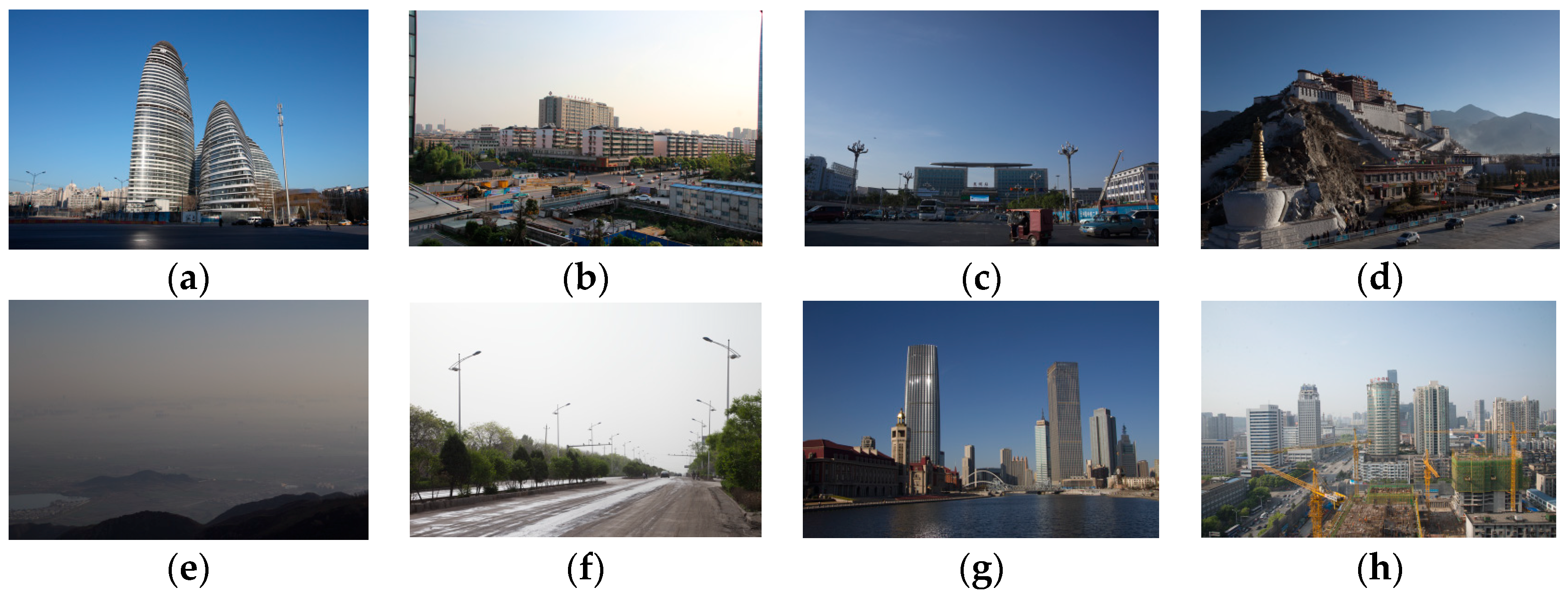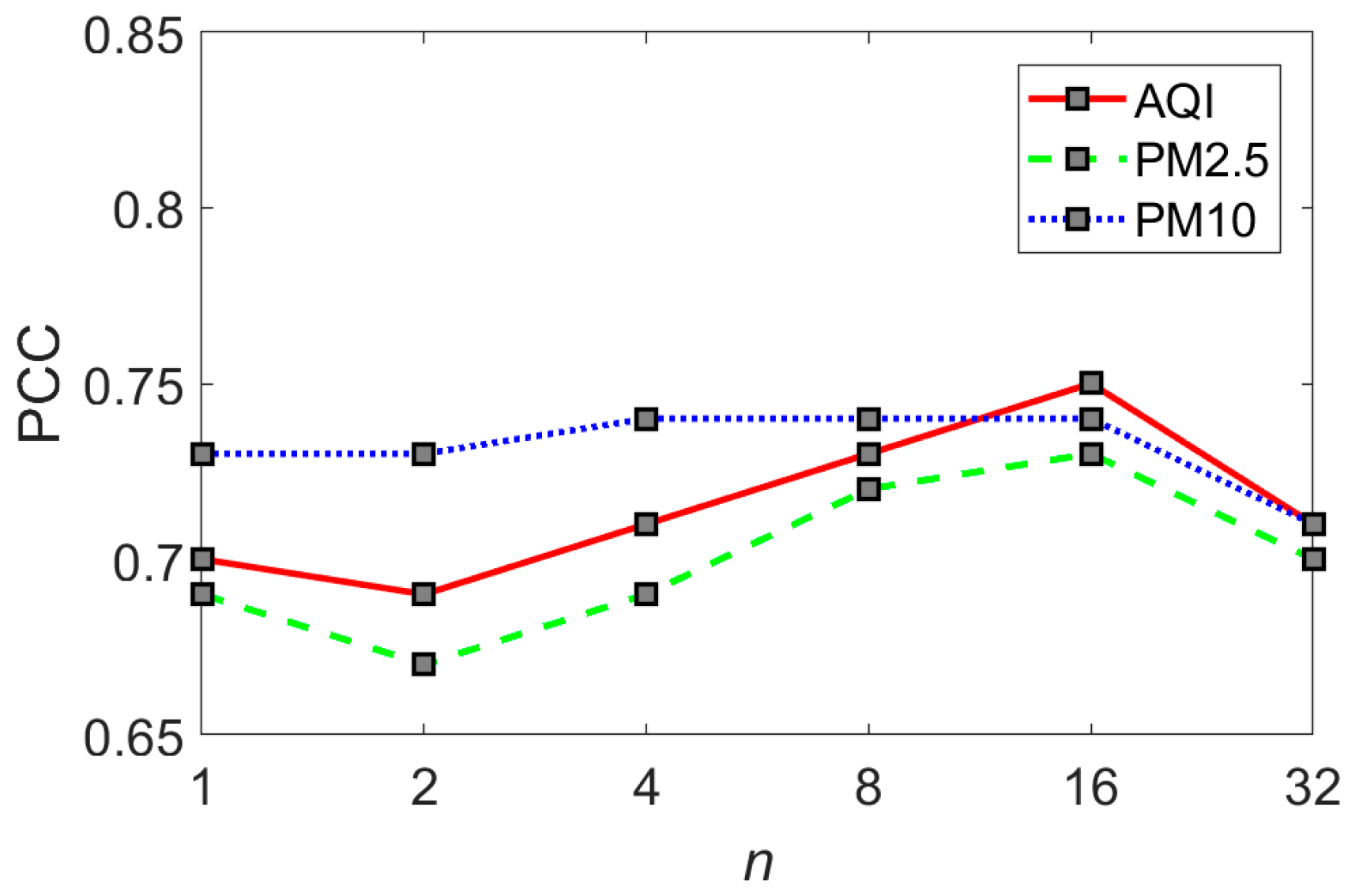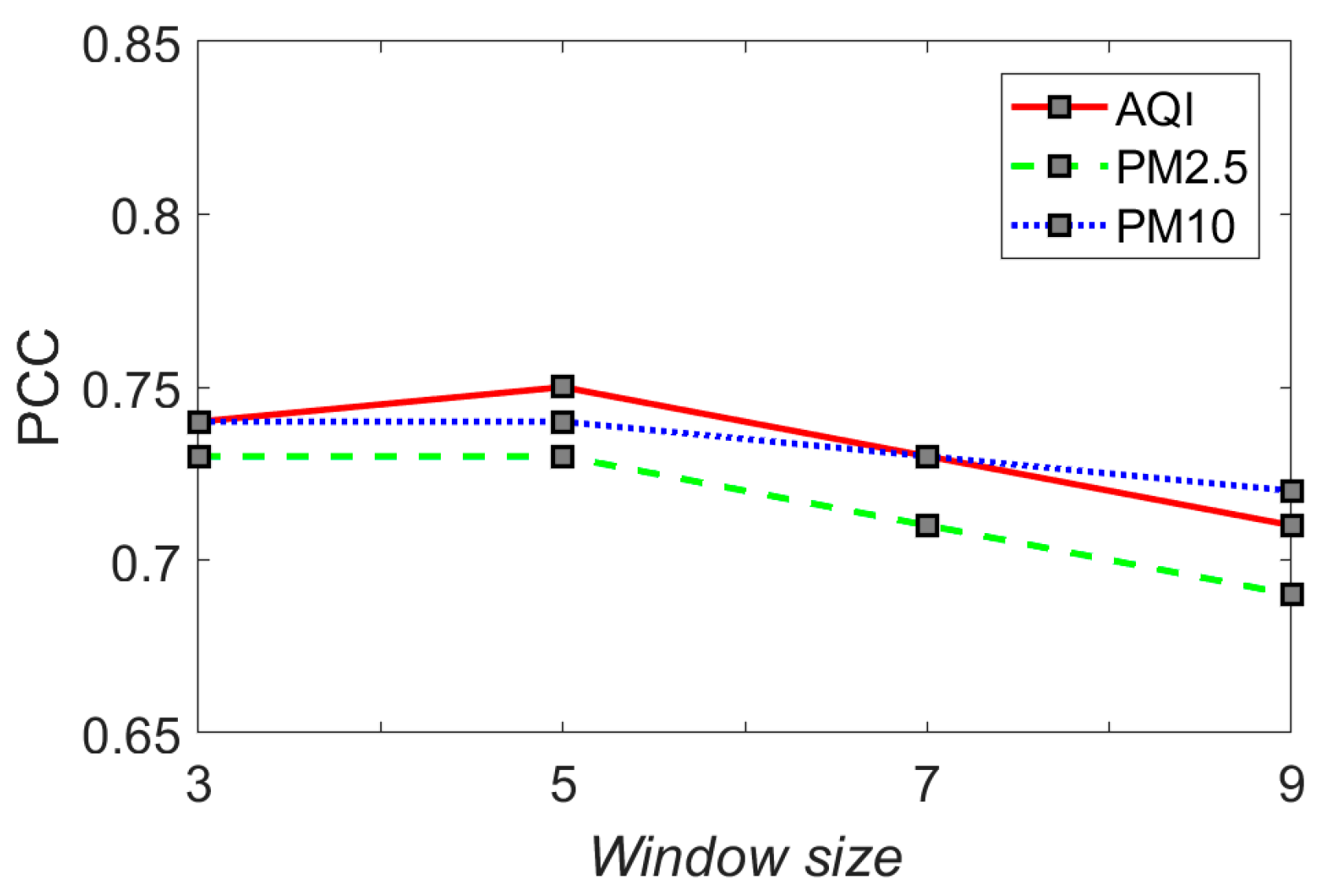Detection of Air Pollution in Urban Areas Using Monitoring Images
Abstract
:1. Introduction
2. Dataset and Method
2.1. RHID_AQI Dataset
2.2. Subjective Index Versus Air Quality
2.3. Method
2.3.1. Motivation
2.3.2. Insensitive Property
2.3.3. fastDBCP
3. Experimental Results
3.1. Parameter Selection
3.2. Performance Comparison
3.3. Computation Cost
4. Discussion
4.1. Application in Air Pollution Classfication
4.2. Application in Real-Time Monitoring System
5. Conclusions
Author Contributions
Funding
Data Availability Statement
Acknowledgments
Conflicts of Interest
References
- Wong, C.J.; Matjafri, M.Z.; Abdullah, K.; Lim, H.S.; Low, K.L. Temporal air quality monitoring using surveillance camera. In Proceedings of the 2007 Geoscience and Remote Sensing Symposium, Barcelona, Spain, 23–28 July 2007; pp. 2864–2868. [Google Scholar] [CrossRef]
- Sallis, P.; Dannheim, C.; Icking, C.; Maeder, M. Air pollution and fog detection through vehicular sensors. In Proceedings of the 8th Asia Modelling Symposium, Taipei, Taiwan, 23–25 September 2014; pp. 181–186. [Google Scholar] [CrossRef]
- Mukundan, A.; Huang, C.C.; Men, T.C.; Lin, F.C.; Wang, H.C. Air pollution detection using a novel snap-shot hyperspectral imaging technique. Sensors 2022, 22, 6231. [Google Scholar] [CrossRef]
- Ma, K.; Liu, W.; Zhang, K.; Duanmu, Z.; Wang, Z.; Zuo, W. End-to-end blind image quality assessment using deep neural networks. IEEE Trans. Image Process. 2018, 27, 1202–1213. [Google Scholar] [CrossRef] [PubMed]
- Min, X.; Zhai, G.; Gu, K.; Yang, X.; Guan, X. Objective quality evaluation of dehazed images. IEEE Trans. Intell. Transp. Syst. 2019, 20, 2879–2892. [Google Scholar] [CrossRef]
- Li, B.; Ren, W.; Fu, D.; Tao, D.; Feng, D.; Zeng, W.; Wang, Z. Benchmarking single-image dehazing and beyond. IEEE Trans. Image Process. 2019, 28, 492–505. [Google Scholar] [CrossRef] [PubMed]
- Ancuti, C.O.; Ancuti, C.; Timofte, R. NH-HAZE: An image dehazing benchmark with non-homogeneous hazy and haze-free images. In Proceedings of the IEEE Computer Society Conference on Computer Vision and Pattern Recognition Workshops, Seattle, WA, USA, 14–19 June 2020; pp. 1798–1805. [Google Scholar] [CrossRef]
- Zhao, S.; Zhang, L.; Huang, S.; Shen, Y.; Zhao, S. Dehazing evaluation: Real-world benchmark datasets, criteria, and baselines. IEEE Trans. Image Process. 2020, 29, 6947–6962. [Google Scholar] [CrossRef]
- Sahu, G.; Seal, A.; Bhattacharjee, D.; Nasipuri, M.; Brida, P.; Krejcar, O. Trends and prospects of techniques for haze removal from degraded images: A survey. IEEE Trans. Emerg. Top. Comput. Intell. 2022, 6, 762–782. [Google Scholar] [CrossRef]
- Korhonen, J. Two-level approach for no-reference consumer video quality assessment. IEEE Trans. Image Process. 2019, 28, 5923–5938. [Google Scholar] [CrossRef]
- Tu, Z.; Wang, Y.; Birkbeck, N.; Adsumilli, B.; Bovik, A.C. UGC-VQA: Benchmarking blind video quality assessment for user generated content. IEEE Trans. Image Process. 2021, 30, 4449–4464. [Google Scholar] [CrossRef] [PubMed]
- Fu, X.; Lin, Q.; Guo, W.; Ding, X.; Huang, Y. Single image dehaze under non-uniform illumination using bright channel prior. J. Theor. Appl. Inf. Technol. 2013, 48, 1843–1848. [Google Scholar]
- Kang, L.; Ye, P.; Li, Y.; Doermann, D. Convolutional neural networks for no-reference image quality assessment. In Proceedings of the 2014 IEEE Conference on Computer Vision and Pattern Recognition, Columbus, OH, USA, 23–28 June 2014; pp. 1733–1740. [Google Scholar] [CrossRef]
- Choi, L.K.; You, J.; Bovik, A.C. Referenceless prediction of perceptual fog density and perceptual image defogging. IEEE Trans. Image Process. 2015, 24, 3888–3901. [Google Scholar] [CrossRef]
- Bosse, S.; Maniry, D.; Müller, K.R.; Wiegand, T.; Samek, W. Deep neural networks for no-reference and full-reference image quality assessment. IEEE Trans. Image Process. 2018, 27, 206–219. [Google Scholar] [CrossRef] [PubMed]
- Chu, Y.; Chen, F.; Fu, H.; Yu, H.Y. Haze level evaluation using dark and bright channel prior information. Atmosphere 2022, 13, 683. [Google Scholar] [CrossRef]
- Chu, Y.; Chen, Z.; Fu, Y.; Yu, H. Haze image database and preliminary assessments. In Proceedings of the Fully 3D Conference, San Diego, CA, USA, 18–23 June 2017; pp. 825–830. [Google Scholar]
- The Breath of China: Public-Benefit Exhibition. Available online: http://slide.news.sina.com.cn/x/slide_1_61471_68613.html/d/8#p=1 (accessed on 31 March 2023).
- Technical Regulation on Ambient Air Quality Index (on Trial). Available online: https://www.mee.gov.cn/ywgz/fgbz/bz/bzwb/jcffbz/201203/t20120302_224166.shtml (accessed on 3 April 2023).
- Final Report from the Video Quality Experts Group on the Validation of Objective Models of Video Quality Assessment—Phase II. Available online: http://www.vqeg.org (accessed on 31 March 2023).
- Pui, D.Y.H.; Chen, S.C.; Zuo, Z.L. PM2.5 in China: Measurements, sources, visibility and health effects, and mitigation. Particuology 2014, 13, 1–26. [Google Scholar] [CrossRef]
- Oliveira, M.; Slezakova, K.; Delerue-Matos, C.; Pereira, M.C.; Morais, S. Children environmental exposure to particulate matter and polycyclic aromatic hydrocarbons and biomonitoring in school environments: A review on indoor and outdoor exposure levels, major sources and health impacts. Environ. Int. 2019, 124, 180–204. [Google Scholar] [CrossRef] [PubMed]
- Wang, Z.; Bovik, A.C.; Sheikh, H.R.; Simoncelli, E.P. Image quality assessment: From error visibility to structural similarity. IEEE Trans. Image Process. 2004, 13, 600–612. [Google Scholar] [CrossRef] [PubMed]
- Saad, M.A.; Bovik, A.C.; Charrier, C. Blind image quality assessment: A natural scene statistics approach in the DCT domain. IEEE Trans. Image Process. 2012, 21, 3339–3352. [Google Scholar] [CrossRef] [PubMed]
- Xue, W.; Mou, X.; Zhang, L.; Bovik, A.C.; Feng, X. Blind image quality assessment using joint statistics of gradient magnitude and Laplacian features. IEEE Trans. Image Process. 2014, 23, 4850–4862. [Google Scholar] [CrossRef]
- Mittal, A.; Moorthy, A.K.; Bovik, A.C. No-reference image quality assessment in the spatial domain. IEEE Trans. Image Process. 2012, 21, 4695–4708. [Google Scholar] [CrossRef]
- Chu, Y.; Mou, X.; Fu, H.; Ji, Z. Blind image quality assessment using statistical independence in the divisive normalization transform domain. J. Electron. Imaging 2015, 24, 063008. [Google Scholar] [CrossRef]
- Moorthy, A.K.; Bovik, A.C. A two-step framework for constructing blind image qualityindices. IEEE Signal Process. Lett. 2010, 17, 513–516. [Google Scholar] [CrossRef]
- Liu, L.; Dong, H.; Huang, H.; Bovik, A.C. No-reference image quality assessment in curvelet domain. Signal Process. Image Commun. 2014, 29, 494–505. [Google Scholar] [CrossRef]
- Moorthy, A.K.; Bovik, A.C. Blind image quality assessment: From natural scene statistics to perceptual quality. IEEE Trans. Image Process. 2011, 20, 3350–3364. [Google Scholar] [CrossRef] [PubMed]
- He, K.; Sun, J.; Tang, X. Single image haze removal using dark channel prior. IEEE Trans. Pattern Anal. Mach. Intell. 2011, 33, 2341–2353. [Google Scholar] [CrossRef]
- Wang, Y.T.; Zhuo, S.J.; Tao, D.P.; Bu, J.J.; Li, N. Automatic local exposure correction using bright channel prior for under-exposed images. Signal Process. 2013, 93, 3227–3238. [Google Scholar] [CrossRef]
- He, K.; Sun, J.; Tang, X. Guided image filtering. IEEE Trans. Pattern Anal. Mach. Intell. 2013, 35, 1397–1409. [Google Scholar] [CrossRef]
- Otsu, N. A threshold selection method from gray-level histograms. IEEE Trans. Syst. Man Cybern. 1979, 9, 62–66. [Google Scholar] [CrossRef]
- Zhan, Y.; Zhang, R.; Wu, Q.; Wu, Y. A new haze image database with detailed air quality information and a novel no-reference image quality assessment method for haze images. In Proceedings of the 2016 IEEE International Conference on Acoustics, Speech and Signal Processing, Shanghai, China, 20–25 March 2016; pp. 1095–1099. [Google Scholar] [CrossRef]
- Li, Y.; Huang, J.; Luo, J. Using user generated online photos to estimate and monitor air pollution in major cities. In Proceedings of the 7th International Conference on Internet Multimedia Computing and Service, Zhangjiajie, China, 19–21 August 2015; pp. 11–15. [Google Scholar] [CrossRef]
- Hsieh, C.H.; Horng, S.C.; Huang, Z.J.; Zhao, Q. Objective haze removal assessment based on two-objective optimization. In Proceedings of the IEEE 8th International Conference on Awareness Science and Technology, Taichung, Taiwan, 8–10 November 2017; pp. 279–283. [Google Scholar] [CrossRef]
- Lu, H.; Zhao, Y.; Zhao, Y.; Wen, S.; Ma, J.; Keung, L.H.; Wang, H. Image defogging based on combination of image bright and dark channels. Guangxue Xuebao/Acta Opt. Sin. 2018, 38, 1115004. [Google Scholar] [CrossRef]
- Johari, A.; Swami, P.D. Comparison of autonomy and study of deep learning tools for object detection in autonomous self driving vehicles. In Proceedings of the 2nd International Conference on Data, Engineering and Applications, Bhopal, India, 28–29 February 2020; pp. 1–6. [Google Scholar] [CrossRef]
- Ichoku, C.; Kaufman, Y.J. A method to derive smoke emission rates from MODIS fire radiative energy measurements. IEEE Trans. Geosci. Remote Sens. 2005, 43, 2636–2649. [Google Scholar] [CrossRef]
- Jun, L.; Honggen, Z.; Jianbing, L.; Xinan, L. Research on the networking strategy of tornado observation network in northern Jiangsu based on X-band weather radar. In Proceedings of the 2019 International Conference on Meteorology Observations, Chengdu, China, 28–31 December 2019; pp. 1–4. [Google Scholar] [CrossRef]
- Smog in Beijing. Available online: http://www.cd-pa.com/bbs/thread-572953-1-1.html (accessed on 1 April 2023).
- Forest Fire in Xichang. Available online: https://sputniknews.cn/20200331/1031118848.html (accessed on 1 April 2023).
- High-Definition Tornado Pictures. Available online: https://www.jj20.com/tp/242085.html (accessed on 1 April 2023).
- Chu, Y.; Luo, G.; Chen, F. A real haze video database for haze level evaluation. In Proceedings of the 13th International Conference on Quality of Multimedia Experience, Montreal, QC, Canada, 14–17 June 2021; pp. 69–72. [Google Scholar] [CrossRef]










| AQI | Air Pollution Level | Air Pollution Category | Classification Label | Classification Category |
|---|---|---|---|---|
| 0–50 | 1 | good | 0 | unpolluted |
| 51–100 | 2 | moderate | 0 | unpolluted |
| 101–150 | 3 | lightly polluted | 1 | polluted |
| 151–200 | 4 | moderately polluted | 1 | polluted |
| 201–300 | 5 | heavily polluted | 1 | polluted |
| >300 | 6 | severely polluted | 1 | polluted |
| Method | AQI | PM2.5 | PM10 |
|---|---|---|---|
| MOS | 0.71 | 0.70 | 0.70 |
| [35] | 0.68 | 0.66 | 0.71 |
| [36] | 0.32 | 0.36 | 0.30 |
| [12] | 0.68 | 0.66 | 0.74 |
| [37] | 0.34 | 0.36 | 0.30 |
| [38] | 0.19 | 0.09 | 0.31 |
| [38] | 0.53 | 0.48 | 0.60 |
| [38] | 0.64 | 0.62 | 0.67 |
| [14] | 0.65 | 0.64 | 0.71 |
| DBCP-I [16] | 0.68 | 0.66 | 0.73 |
| DBCP-II [16] | 0.69 | 0.68 | 0.72 |
| DBCP-III [16] | 0.71 | 0.69 | 0.75 |
| CNN [13] | 0.68 | 0.66 | 0.72 |
| DIQaM-NR [15] | 0.75 | 0.72 | 0.75 |
| fastDBCP | 0.75 | 0.73 | 0.74 |
| Method | DBCP-I | DBCP-II | DBCP-III | CNN | DIQaM-NR | fastDBCP | ||||
|---|---|---|---|---|---|---|---|---|---|---|
| Computation time (s) | 1.34 | 0.07 | 0.02 | 1.86 | 2.79 | 1.54 | 2.80 | 0.33 | 0.81 | 0.08 |
| Method | DBCP-I | DBCP-II | DBCP-III | CNN | DIQaM-NR | fastDBCP | ||||
|---|---|---|---|---|---|---|---|---|---|---|
| (%) | 78.74 | 75.42 | 77.74 | 54.49 | 77.74 | 79.40 | 81.06 | 54.49 | 54.49 | 82.39 |
| Method | DBCP-I | DBCP-II | DBCP-III | CNN | DIQaM-NR | fastDBCP | ||||
|---|---|---|---|---|---|---|---|---|---|---|
| PCC | 0.79 | 0.81 | 0.70 | 0.82 | 0.88 | 0.93 | 0.92 | 0.85 | 0.93 | 0.91 |
Disclaimer/Publisher’s Note: The statements, opinions and data contained in all publications are solely those of the individual author(s) and contributor(s) and not of MDPI and/or the editor(s). MDPI and/or the editor(s) disclaim responsibility for any injury to people or property resulting from any ideas, methods, instructions or products referred to in the content. |
© 2023 by the authors. Licensee MDPI, Basel, Switzerland. This article is an open access article distributed under the terms and conditions of the Creative Commons Attribution (CC BY) license (https://creativecommons.org/licenses/by/4.0/).
Share and Cite
Chu, Y.; Chen, F.; Fu, H.; Yu, H. Detection of Air Pollution in Urban Areas Using Monitoring Images. Atmosphere 2023, 14, 772. https://doi.org/10.3390/atmos14050772
Chu Y, Chen F, Fu H, Yu H. Detection of Air Pollution in Urban Areas Using Monitoring Images. Atmosphere. 2023; 14(5):772. https://doi.org/10.3390/atmos14050772
Chicago/Turabian StyleChu, Ying, Fan Chen, Hong Fu, and Hengyong Yu. 2023. "Detection of Air Pollution in Urban Areas Using Monitoring Images" Atmosphere 14, no. 5: 772. https://doi.org/10.3390/atmos14050772
APA StyleChu, Y., Chen, F., Fu, H., & Yu, H. (2023). Detection of Air Pollution in Urban Areas Using Monitoring Images. Atmosphere, 14(5), 772. https://doi.org/10.3390/atmos14050772








